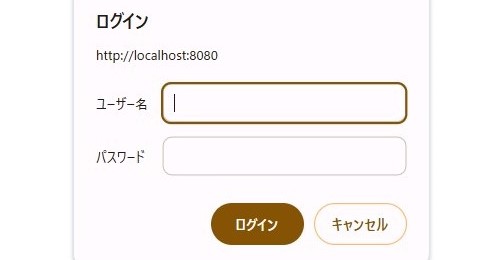【Tomcatログイン制御】セキュアで柔軟なDB更新ページを作りたい話
2025-05-03 プログラム・IT
ある日、こう思いました。
「DBのデータ、ちょこちょこ更新するの正直めんどくさい……」
あるあるですよね。特に更新頻度の高いデータを、いちいちMySQL接続して変更するのはダルい。
なので今回は、ログイン制御されたWebページからDBのデータを更新できるように、Tomcatを使って実装してみました。
制限をかけたいのは /fan/* 配下のページ。
使用バージョンは Tomcat 9。
BASIC認証(超シンプル。でも柔軟性は低め)
「web.xml にアクセス制限領域を設定」して「tomcat-users.xml にユーザーを設定」をする方法でやっていきます。
<security-constraint>
<web-resource-collection>
<web-resource-name>Restricted Area</web-resource-name>
<url-pattern>/fan/*</url-pattern> <!-- ここに制限したいディレクトリ -->
</web-resource-collection>
<auth-constraint>
<role-name>user</role-name>
</auth-constraint>
</security-constraint>
<login-config>
<auth-method>BASIC</auth-method>
<realm-name>Restricted Area</realm-name>
</login-config>
<security-role>
<role-name>user</role-name>
</security-role><tomcat-users>
<user username="admin" password="password123" roles="user"/>
</tomcat-users>すると、web.xmlで指定したディレクトリで

ブラウザのポップアップによる認証画面になります。
これが実装が最も簡単なんだけど、以下のデメリット
- UIがブラウザ依存でカスタマイズ不可
- パスワードを平文で送る(HTTPSが必須)
- DB連携やユーザーごとの詳細制御が困難
- ログアウトが困難(ブラウザのキャッシュによる)
もうちょい、自由度の高い機能にしたいですね。
FORM認証(Tomcat標準。HTMLでログイン画面を作れる)
tomcat-users.xml のユーザーの設定はそのままで、カスタムしたhtmlページでログイン制御を行います。
<security-constraint>
<web-resource-collection>
<web-resource-name>Restricted Area</web-resource-name>
<url-pattern>/fan/*</url-pattern> <!-- ここに制限したいディレクトリ -->
</web-resource-collection>
<auth-constraint>
<role-name>user</role-name>
</auth-constraint>
</security-constraint>
<login-config>
<auth-method>FORM</auth-method>
<realm-name>Restricted Area</realm-name>
<form-login-config>
<form-login-page>/fan-login.html</form-login-page> <!-- ログインページ -->
<form-error-page>/login-error.html</form-error-page>
</form-login-config>
</login-config>
<security-role>
<role-name>user</role-name>
</security-role>
ログイン制御画面では、Tomcatが予約している "j_security_check" にPOSTするように設定。
<form method="POST" action="j_security_check">
<input type="text" name="j_username" placeholder="ユーザー名">
<input type="password" name="j_password" placeholder="パスワード">
<button type="submit">ログイン</button>
</form>Tomcatの仕組みを使うので、わりと簡単で、これが正解かもしれない…
けど、db接続とかを考慮すると、server.xmlとかにdb接続設定とか書かなくてはならず、構成を変えなければならず、個人的にはjavaとかで制御したい…
Filter + Servlet + DB(最も柔軟で現実的)
最終的に選んだのがこの方法。
Filterでアクセス制御、Servletでログイン処理、DBでユーザー認証。全部自前で作ります。
<filter>
<filter-name>AuthFilter</filter-name>
<filter-class>test.AuthFilter</filter-class>
</filter>
<filter-mapping>
<filter-name>AuthFilter</filter-name>
<url-pattern>/fan/*</url-pattern>
</filter-mapping>/fan/*にアクセスした場合に飛ばす先としてセッションチェックを行うAuthFilterクラスを作成
public class AuthFilter implements Filter {
public void doFilter(ServletRequest request, ServletResponse response, FilterChain chain)
throws IOException, ServletException {
// リクエスト・レスポンスをHTTP用にキャスト(HTTPの機能を使うため)
HttpServletRequest req = (HttpServletRequest) request;
HttpServletResponse res = (HttpServletResponse) response;
// 現在のセッションを取得(存在しない場合は null を返す)
HttpSession session = req.getSession(false);
// セッションまたはログイン情報がなければ、ログインページへリダイレクト
if (session == null || session.getAttribute("fanusername") == null) {
res.sendRedirect(req.getContextPath() + "/fan-login.html");
return;
}
// 無操作時間をリセット(3分)し、次の処理へ渡す。
session.setMaxInactiveInterval(180);
chain.doFilter(request, response);
}
}ログインページはこんな感じ
<form method="POST" action="/fanLoginServlet">
<label>ユーザー名: </label><input type="text" name="username" required>
<label>パスワード: </label><input type="password" name="password" required>
<input type="submit" value="ログイン">
</form>ログイン認証とセッション開始を行うコードサーブレットを作成。
@WebServlet("/fanLoginServlet")
public class LoginServlet extends HttpServlet {
protected void doPost(HttpServletRequest request, HttpServletResponse response)
throws ServletException, IOException {
// リクエストパラメータを取得
String username = request.getParameter("username");
String password = request.getParameter("password");
// ユーザー認証
if (isValidUser(username, password)) {
HttpSession session = request.getSession();
session.setAttribute("fanusername", username);
session.setMaxInactiveInterval(180); // 3分で自動ログアウト
response.sendRedirect("/fan/tobishimaProcedure.html"); // 認証成功後のリダイレクト先
} else {
response.sendRedirect("/fan-login.html?error=1"); // 認証失敗後のリダイレクト先
}
}
/**
* ユーザー名とパスワードを使って、認証を行うメソッド。
*
* @param username 入力されたユーザー名
* @param password 入力されたパスワード(プレーンテキスト)
* @return 認証に成功すれば true、失敗すれば false
*/
private boolean isValidUser(String username, String password) {
~ (略)~
}
}柔軟に管理したいなら、自前実装一択!
というわけで、Filter+Servlet方式で自由に認証とDB操作ができる構成にしてみました。
誰かの参考になればうれしいです。
次回は「パスワードのハッシュ化」について書くかも?
 みっつー
みっつー